Control and Identification of Invasive Species - Grow Native
Control and Identification of Invasive Species - Grow Native
Control and Identification of Invasive Species - Grow Native
You also want an ePaper? Increase the reach of your titles
YUMPU automatically turns print PDFs into web optimized ePapers that Google loves.
19sometimes confused with privet. The flowers<strong>of</strong> Amur honeysuckle are faintly fragrant. Thisshrub was improved by breeding for greaterfruit production bythe USDA in Missouri, <strong>and</strong> has been plantedfor l<strong>and</strong>scaping <strong>and</strong> attracting wildlife acrossthe eastern US. In fact, bush honeysuckle providespoor quality food <strong>and</strong> habitat for birds. Itthrives from Maryl<strong>and</strong> <strong>and</strong> Virginia to Missouri<strong>and</strong> eastern Kansas. Plantings are known torapidly spread to nearby forests where theycan occupy several square miles <strong>of</strong> woodedareas within 5 years. Similar stories could berepeated all over the St. Louis <strong>and</strong> Kansas Cityregions in Missouri.Small infestations can be killed with mostwide-spectrum <strong>and</strong> broadleaf-specificherbicides (RoundUp or Garlon) applied to thefoliage at 1.5-4% concentration. Timingis important, with late growing season(September-October) applications <strong>of</strong>tenreported to be more lethal than those inearlier or later months. Homeowners should beaware that brush from bush honeysuckle containingberries contains seeds <strong>and</strong> should notbe put into municipal mulch piles to avoidspreading the seed further. Largerindividuals are best controlled in fall orwinter with either basal or cut stumptreatments <strong>of</strong> Garlon or related herbicidesat 20% concentration.In cold weather, diluting herbicides withwindshield-washer fluid rather than waterprevents freezing <strong>and</strong> may improve penetrationinto plant tissues. Prescribed burning will onlytop-kill plants. Plants will re-sprout from theroots but flowering <strong>and</strong> seed production areset back two seasons. Unless burning is frequent,mechanical or chemical removal are theonly effective means <strong>of</strong> control.Japanese honeysuckleLonicera japonicaJapanese honeysuckle (an “evergreen” woodyvine) historically was much-loved in gardensfor the delicious fragrance <strong>of</strong> its flowers.In nature however, it is a plague throughoutthe Eastern United States. The flowers openwhite <strong>and</strong> turn creamy yellow, emitting thefragrance for which they are famed. The fruit isThe berries <strong>of</strong> Amur honeysuckle (above) are attractive to the human eye <strong>and</strong> are eaten eagerlyby migrating <strong>and</strong> resident birds, which disperse the seeds in their droppings.Amur or Bush honeysuckleLonicera maackiiBushhoneysuckle (a woody shrub) is <strong>of</strong>ten mistakenlyreferred to as Japanese honeysuckle, <strong>and</strong>


